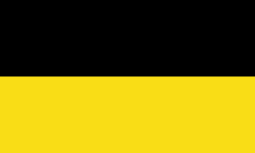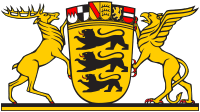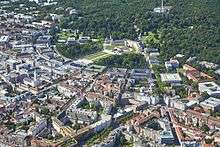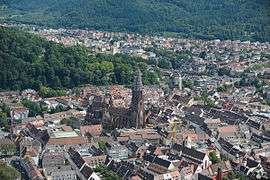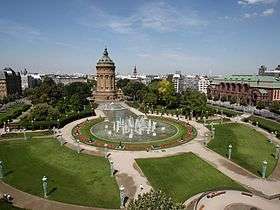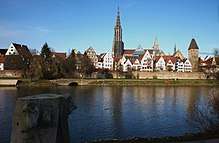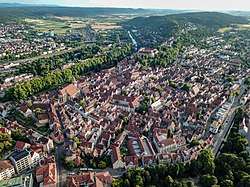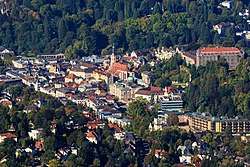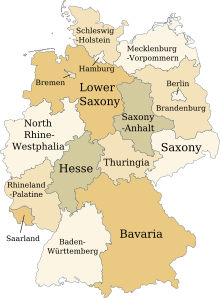Baden-Württemberg
Baden-Württemberg (/ˌbɑːdən ˈvɜːrtəmbɜːrɡ/,[5] German: [ˌbaːdn̩ ˈvʏʁtəmbɛʁk] (![]()
Baden-Württemberg | |
|---|---|
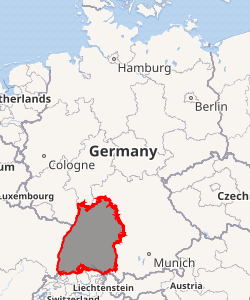
| |
| Coordinates: 48°32′16″N 9°2′28″E | |
| Country | Germany |
| Capital | Stuttgart |
| Government | |
| • Body | Landtag of Baden-Württemberg |
| • Minister-President | Winfried Kretschmann (Greens) |
| • Governing parties | Greens / CDU |
| • Bundesrat votes | 6 (of 69) |
| Area | |
| • Total | 35,751.46 km2 (13,803.72 sq mi) |
| Population (2017-12-31)[2] | |
| • Total | 11,023,424 |
| • Density | 310/km2 (800/sq mi) |
| Time zone | UTC+1 (CET) |
| • Summer (DST) | UTC+2 (CEST) |
| ISO 3166 code | DE-BW |
| GRP (nominal) | €524 billion (2019)[3] |
| GRP per capita | €47,000 (2019) |
| NUTS Region | DE1 |
| HDI (2018) | 0.953[4] very high · 2nd of 16 |
| Website | www.baden-wuerttemberg.de |
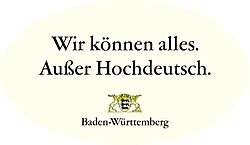
The sobriquet Ländle ("little land" in the local Swabian and Alemannic German dialects) is sometimes used as a synonym for Baden-Württemberg.[7][8]
History
Baden-Württemberg is formed from the historical territories of Baden, Prussian Hohenzollern, and Württemberg.[9]
In 100 AD, the Roman Empire invaded and occupied Württemberg, constructing a limes (fortified boundary zone) along its northern borders. Over the course of the third century AD, the Alemanni forced the Romans to retreat west beyond the Rhine and Danube rivers. In 496 AD the Alemanni were defeated by a Frankish invasion led by Clovis I.
The Holy Roman Empire was later established. The majority of people in this region continued to be Roman Catholics, even after the Protestant Reformation influenced populations in northern Germany.
In the late 18th and early 19th century, Künzelsau, the capital of the Hohenlohe (district), became the centre of emigration to the UK of pork butchers and bacon factors. The pioneers noticed a niche for specialty pork products in the rapidly growing English cities, especially those in the industrial centre and North. Many married local women and sent word home that a good living could be made in England; others followed.[10]
In the late-nineteenth and early-twentieth centuries, numerous people emigrated from this mostly rural area to the United States for economic reasons.
20th century to present
After World War II, the Allies established three federal states in the territory of modern-day Baden-Württemberg: Württemberg-Hohenzollern, Baden, and Württemberg-Baden. Baden and Württemberg-Hohenzollern were occupied by France, while Württemberg-Baden was occupied by the United States. In 1949, each state became a founding member of the Federal Republic of Germany, with Article 118 of the German constitution providing an accession procedure. On 16 December 1951, Württemberg-Baden, Württemberg-Hohenzollern and Baden voted via a referendum in favor of a joint merger.[6] Baden-Württemberg officially became a state in West Germany on 25 April 1952.[6]
Geography
Baden-Württemberg shares borders with the German states of Rhineland Palatinate, Hessen, and Bavaria, and also shares borders with France (region of Grand Est), and Switzerland (cantons of Basel-Landschaft, Basel-Stadt, Aargau, Zürich, Schaffhausen and Thurgau).[6]
Most of the major cities of Baden-Württemberg straddle the banks of the Neckar River, which runs downstream (from southwest to the center, then northwest) through the state past Tübingen, Stuttgart, Heilbronn, Heidelberg, and Mannheim.
The Rhine (German: Rhein) forms the western border as well as large portions of the southern border. The Black Forest (Schwarzwald), the main mountain range of the state, rises east of the Upper Rhine valley. The high plateau of the Swabian Alb, between the Neckar, the Black Forest, and the Danube, is an important European watershed. Baden-Württemberg shares Lake Constance (Bodensee, also known regionally as the Swabian Sea) with Switzerland, Austria and Bavaria, the international borders within its waters not being clearly defined. It shares the foothills of the Alps (known as the Allgäu) with Bavaria and the Austrian Vorarlberg, but Baden-Württemberg itself has no mainland border with Austria.
The Danube River (Donau) has its source in Baden-Württemberg near the town of Donaueschingen, in a place called Furtwangen in the Black Forest.
Government
| Year | Pop. | ±% p.a. |
|---|---|---|
| 1871 | 3,349,409 | — |
| 1900 | 4,107,325 | +0.71% |
| 1933 | 5,185,618 | +0.71% |
| 1950 | 6,430,225 | +1.27% |
| 1960 | 7,726,859 | +1.85% |
| 1970 | 8,895,048 | +1.42% |
| 1980 | 9,258,947 | +0.40% |
| 1990 | 9,822,027 | +0.59% |
| 2000 | 10,524,415 | +0.69% |
| 2010 | 10,753,880 | +0.22% |
| 2018 | 11,069,533 | +0.36% |
| source:[11] | ||
Administration
Baden-Württemberg is divided into thirty-five districts (Landkreise) and nine independent cities (Stadtkreise), both grouped into the four Administrative Districts (Regierungsbezirke) of Freiburg, Karlsruhe, Stuttgart, and Tübingen.
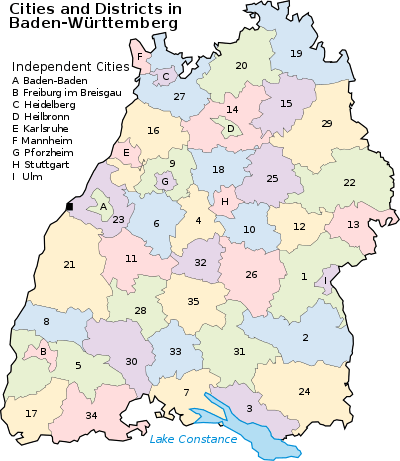
Map
|
Baden-Württemberg contains nine additional independent cities not belonging to any district:
| Code | City (stadtkreise) | Area (km2) | Population 1997 | Population 2007 |
Population 2017 | Region (regierungs- bezirk) |
|---|---|---|---|---|---|---|
| A | Baden-Baden | 140.18 | 52,672 | 54,853 | 54,718 | Karlsruhe |
| B | Freiburg im Breisgau | 153.06 | 200,519 | 219,430 | 229,636 | Freiburg |
| C | Heidelberg | 108.83 | 139,941 | 145,311 | 160,601 | Karlsruhe |
| D | Heilbronn | 99.88 | 120,987 | 121,627 | 125,113 | Stuttgart |
| E | Karlsruhe | 173.46 | 276,571 | 288,917 | 311,919 | Karlsruhe |
| F | Mannheim | 144.96 | 310,475 | 309,795 | 307,997 | Karlsruhe |
| G | Pforzheim | 98.02 | 118,079 | 119,423 | 124,289 | Karlsruhe |
| H | Stuttgart | 207.35 | 585,274 | 597,176 | 632,743 | Stuttgart |
| I | Ulm | 118.69 | 115,628 | 121,434 | 125,596 | Tübingen |
Politics
The state parliament of Baden-Württemberg is the Landtag (Eng. state assembly).
The politics of Baden-Württemberg have traditionally been dominated by the conservative Christian Democratic Union of Germany (CDU), who until 2011 had led all but one government since the establishment of the state in 1952. In the Landtag elections held on 27 March 2011 voters replaced the Christian Democrats and centre-right Free Democrats coalition by a Greens-led alliance with the Social Democrats which secured a four-seat majority in the state parliament.
From 1992 to 2001, the Republicans party held seats in the Landtag.[12]
2016 state election
< 2011 ![]()
| Party | Popular vote | Seats | ||||||||
|---|---|---|---|---|---|---|---|---|---|---|
| Votes | % | +/– | Seats | +/– | ||||||
| Alliance '90/The Greens Bündnis 90/Die Grünen | 1,622,631 | 30.3 | 47 | |||||||
| Christian Democratic Union Christlich Demokratische Union Deutschlands – CDU | 1,447,249 | 27.0 | 42 | |||||||
| Alternative for Germany Alternative für Deutschland – AfD | 809,311 | 15.1 | 23 | |||||||
| Social Democratic Party Sozialdemokratische Partei Deutschlands – SPD | 679,872 | 12.7 | 19 | |||||||
| Free Democratic Party Freie Demokratische Partei – FDP | 445,430 | 8.3 | 12 | |||||||
| Left Party Die Linke | 156,211 | 2.9 | 0 | |||||||
| Alliance for Progress and Renewal Allianz für Fortschritt und Aufbruch – ALFA | 54,764 | 1.0 | 0 | |||||||
| Ecological Democratic Party Ökologisch-Demokratische Partei – ÖDP | 38,509 | 0.7 | 0 | |||||||
| National Democratic Party Nationaldemokratische Partei Deutschlands – NPD | 23,605 | 0.4 | 0 | |||||||
| Pirate Party Piratenpartei | 21,773 | 0.4 | 0 | |||||||
| Other parties | ||||||||||
| Valid votes | 5,360,351 | 99.0 | ||||||||
| Invalid votes | 51,950 | 1.0 | ||||||||
| Totals and voter turnout | 5,412,301 | 70.4 | 143 | |||||||
| Electorate | 7,685,778 | 100.00 | — | |||||||
| Source: Landeswahlleiter[13][14] | ||||||||||
Other state institutions
The Baden-Württemberg General Auditing Office acts as an independent body to monitor the correct use of public funds by public offices.[15]
Economy

Although Baden-Württemberg has relatively few natural resources compared to other regions of Germany,[6] the state is among the most prosperous[9] and wealthiest regions in Europe with a generally low unemployment rate historically. A number of well-known enterprises are headquartered in the state, for example Daimler AG, Porsche, Robert Bosch GmbH (automobile industry), Carl Zeiss AG (optics), SAP SE (largest software enterprise in Europe) and Heidelberger Druckmaschinen (precision mechanical engineering). In spite of this, Baden-Württemberg's economy is dominated by small and medium-sized enterprises. Although poor in workable natural resources (formerly lead, zinc, iron, silver, copper, and salts) and still rural in many areas, the region is heavily industrialised. In 2003, there were almost 8,800 manufacturing enterprises with more than 20 employees, but only 384 with more than 500. The latter category accounts for 43% of the 1.2 million persons employed in industry. The Mittelstand or mid-sized company is the backbone of the Baden-Württemberg economy.[16] Medium-sized businesses and a tradition of branching out into different industrial sectors have ensured specialization over a wide range. A fifth of the "old" Federal Republic's industrial gross value added is generated by Baden-Württemberg. Turnover for manufacturing in 2003 exceeded 240,000 million, 43% of which came from exports. The region depends to some extent on global economic developments, though the great adaptability of the region's economy has generally helped it through crises. Half of the employees in the manufacturing industry are in mechanical and electrical engineering and automobile construction. This is also where the largest enterprises are to be found. The importance of the precision mechanics industry also extends beyond the region's borders, as does that of the optical, clock making, toy, metallurgy and electronics industries. The textile industry, which formerly dominated much of the region, has now all but disappeared from Baden-Württemberg. Research and development (R&D) is funded jointly by the State and industry. In 2001, more than a fifth of the 100,000 or so persons working in R&D in Germany were located in Baden-Württemberg, most of them in the Stuttgart area.[17] Baden-Württemberg is also one of the Four Motors for Europe.
A study performed in 2007 by the PR campaign "Initiative for New Social Market Economy" (German: Initiative Neue Soziale Marktwirtschaft (INSM)) and the trade newspaper Wirtschaftswoche awarded Baden-Württemberg for being the "economically most successful and most dynamic state" among the 16 states.
The unemployment rate stood at 3% in October 2018 and was the second lowest in Germany behind only Bavaria and one of the lowest in the European Union.[18]
| Year[19] | 2000 | 2001 | 2002 | 2003 | 2004 | 2005 | 2006 | 2007 | 2008 | 2009 | 2010 | 2011 | 2012 | 2013 | 2014 | 2015 | 2016 | 2017 |
|---|---|---|---|---|---|---|---|---|---|---|---|---|---|---|---|---|---|---|
| Unemployment rate in % | 5.4 | 4.9 | 5.4 | 6.2 | 6.2 | 7.0 | 6.3 | 4.9 | 4.1 | 5.1 | 4.9 | 4.0 | 3.9 | 4.1 | 4.0 | 3.8 | 3.8 | 3.5 |
Tourism
_(cropped).jpg)
Baden-Württemberg is a popular holiday destination. Main sights include the capital and biggest city, Stuttgart, modern and historic at the same time, with its urban architecture and atmosphere (and famously, its inner city parks and historic Wilhelma zoo), its castles (such as Castle Solitude), its (car and art) museums as well as a rich cultural programme (theatre, opera) and mineral spring baths in Stuttgart-Bad Cannstatt (also the site of a Roman Castra); it is the only major city in Germany with vineyards in an urban territory.
The residential (court) towns of Ludwigsburg and Karlsruhe, the spas and casino of luxurious Baden-Baden, the medieval architecture of Ulm (Ulm Münster is the tallest church in the world), the vibrant, young, but traditional university towns of Heidelberg and Tübingen with their old castles looking out above the river Neckar, are popular smaller towns. Sites of former monasteries such as the ones on Reichenau Island and at Maulbronn (both World Heritage Sites) as well as Bebenhausen Abbey are to be found. Baden-Württemberg also boasts rich old Free Imperial Cities such as Biberach, Esslingen am Neckar, Heilbronn, Ravensburg, Reutlingen, Künzelsau and Schwäbisch Hall, as well as the southernmost and sunniest city of Germany, Freiburg, close to Alsace and Switzerland, being an ideal base for exploring the heights of the nearby Black Forest (e.g., for skiing in winter or for hiking in summer) with its traditional villages and the surrounding wine country of the Rhine Valley of South Baden.[9]
The countryside of the lush Upper Neckar valley (where Rottweil is famous for its carnival (Fastnacht)) and the pristine Danube valley Swabian Alb (with Hohenzollern Castle and Sigmaringen Castle), as well as the largely pristine Swabian Forest, the Upper Rhine Valley, and Lake Constance (German: Bodensee), where all kinds of water sports are popular, with the former Imperial, today border town of Konstanz (where the Council of Constance took place), the Neolithic and Bronze Age village at Unteruhldingen, the flower island of Mainau, and the hometown of the Zeppelin, Friedrichshafen a.o., are especially popular for outdoor activities in the summer months.[9]
In spring and autumn (April/May and September/October), beer festivals (fun fairs) take place at the Cannstatter Wasen in Stuttgart. The Cannstatter Volksfest, in the autumn, is the second largest such festival in the world after the Munich Oktoberfest. In late November and early December Christmas markets are a tourist magnet in all major towns, with the largest being in Stuttgart during the three weeks prior to Christmas.
The Bertha Benz Memorial Route is a 194 km signposted scenic route from Mannheim via Heidelberg and Wiesloch to Pforzheim and back, which follows the route of the world's first long-distance journey by automobile which Bertha Benz undertook in August 1888.
Companies owned by Baden-Württemberg
| Company | Industry | Percentage owned | Source |
|---|---|---|---|
| EnBW | Energy industry | 45% | [20] |
| Badische Staatsbrauerei Rothaus | Beverage industry | 100% | |
Education
_jm33894.jpg)
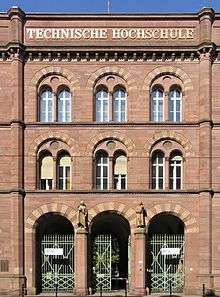
Baden-Württemberg is home to some of the oldest, most renowned, and prestigious universities in Germany, such as the universities of Heidelberg (founded in 1386, the oldest university within the territory of modern Germany), Freiburg (founded in 1457), and Tübingen (founded in 1477). It also contains three of the eleven German 'excellence universities' (Heidelberg, Tübingen, and Konstanz and formerly, Freiburg and Karlsruhe).
Other university towns are Mannheim and Ulm. Furthermore, two universities are located in the state capital Stuttgart, the University of Hohenheim, and the University of Stuttgart. Ludwigsburg is home to the renowned national film school Filmakademie Baden-Württemberg (Film Academy Baden-Wuerttemberg). The private International University in Germany was situated in Bruchsal, but closed in 2009. There is still another private university, located in Friedrichshafen, Zeppelin University.
Furthermore, there are more than a dozen Fachhochschulen, i.e., universities of applied sciences, as well as Pädagogische Hochschulen, i.e., teacher training colleges, and other institutions of tertiary education in Baden-Württemberg. (a.o. in Aalen, Biberach an der Riss, Esslingen, Karlsruhe, Ludwigsburg, Nürtingen, Pforzheim, Ravensburg-Weingarten, Reutlingen, several in Stuttgart, Schwäbisch Hall). Pforzheim University is one of the oldest Fachhochschulen in Germany which is renowned and highly ranked for its Engineering and MBA programs.
The state has the highest density of academic institutions of any territorial state (i.e., excluding the city states of Berlin and Hamburg) in Germany.
Dialects
Two dialect groups of German are spoken in Baden-Württemberg in various variants: Alemannic and Franconian dialects. In central and southern Württemberg, the Alemannic dialect of Swabian is spoken (slightly differing even within the area, e.g., between Upper Swabia, the Swabian Alb, and the central Neckar Valley of the Stuttgart region). In South Baden, the local dialects are Low Alemannic and High Alemannic (i.e., variants of what is also Swiss German). In the northern part of Baden, i.e., the former Kurpfalz (Electorate of the Palatinate) with the former capitals of Heidelberg and Mannheim, the idiom is Rhine Franconian (i.e., Palatinate German), while in the Northeast East Franconian is spoken.
The same or similar Alemannic dialects are also spoken in the neighbouring regions, especially in Bavarian Swabia, Alsace (Alsatian), German-speaking Switzerland (Swiss German), and the Austrian Vorarlberg, while the other Franconian dialects range from the Netherlands over the Rhineland, Lorraine, and Hesse up to northern Bavaria Franconia.
A variant of the Alemannic German of Baden developed into the Colonia Tovar dialect, spoken by descendants of immigrants from Baden who went to Venezuela in 1843. Yiddish and Pleißne were spoken. Romani is in use.[21] The Pleißne was spoken by hawkers selling items such as baskets, brushes, and whips, and belongs to Rotwelsch. It can be used as a code.[22][23][24]
Demographics
The population of Baden-Württemberg is 10,486,660 (2014), of which 5,354,105 are female and 5,132,555 are male. In 2006, the birth rate of 8.61 per 1000 was almost equal to the death rate of 8.60 per 1000. 14.87 percent of the population was under the age of 15, whereas the proportion of people aged 65 and older was at 18.99 per cent (2008). The dependency ratio - the ratio of people aged under 15 and over 64 in comparison to the working age population (aged 15–64) - was 512 per 1000 (2008).
Baden-Württemberg has long been a preferred destination of immigrants. As of 2013, almost 28% of its population had a migration background as defined by the Federal Statistical Office of Germany; this number clearly surpassed the German average of 21% and was higher than in any other German state with the exception of the city states of Hamburg and Bremen.[25] As of 2014, 9,355,239 of the population held German citizenship, whereas 1,131,421 were foreign nationals.[26]
| Rank | Regierungsbezirk | Pop. | |||||||
|---|---|---|---|---|---|---|---|---|---|
 Stuttgart 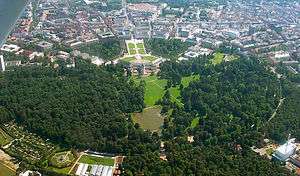 Karlsruhe |
1 | Stuttgart | Stuttgart (region) | 633,164 | 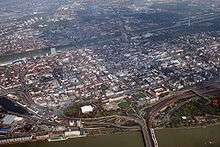 Mannheim  Freiburg im Breisgau | ||||
| 2 | Karlsruhe | Karlsruhe (region) | 311,484 | ||||||
| 3 | Mannheim | Karlsruhe (region) | 308,763 | ||||||
| 4 | Freiburg im Breisgau | Freiburg (region) | 229,341 | ||||||
| 5 | Heidelberg | Karlsruhe (region) | 160,196 | ||||||
| 6 | Ulm | Tübingen (region) | 125,805 | ||||||
| 7 | Heilbronn | Stuttgart (region) | 125,599 | ||||||
| 8 | Pforzheim | Karlsruhe (region) | 125,108 | ||||||
| 9 | Reutlingen | Tübingen (region) | 115,877 | ||||||
| 10 | Esslingen am Neckar | Stuttgart (region) | 93,304 | ||||||
Vital statistics
- Births from January–March 2017 =

- Births from January–March 2018 =

- Deaths from January–March 2017 =

- Deaths from January–March 2018 =

- Natural growth from January–March 2017 =

- Natural growth from January–March 2018 =

Religion
Northern and most of central Württemberg has been traditionally Protestant (particularly Lutheran) since the Reformation in 1534 (with its centre at the famous Tübinger Stift). The former Electorate of the Palatinate (Northwestern Baden) with its capital Heidelberg was shaped by Calvinism before being integrated into Baden. Upper Swabia, and the Upper Neckar Valley up to the bishop seat of Rottenburg, and Southern Baden (the Catholic archbishop has its seat in Freiburg) have traditionally been bastions of Roman Catholicism.
Foreigners
As of January 1 2020, largest groups of foreign residents by country of origin were:
| 253,995 | |
| 184,555 | |
| 156,325 | |
| 122,835 | |
| 85,620 | |
| 82,135 | |
| 81,260 | |
| 62,615 | |
| 52,450 | |
| 44,770 | |
See also
- Minister-President of Baden-Württemberg
- List of places in Baden-Württemberg
- Four Motors of Europe
- History of Baden-Württemberg
- Württemberg
- Coat of arms of Baden
- Margraviate of Baden, for the 16th-18th century state
- Electorate of Baden, for the Napoleonic state
- Grand Duchy of Baden, for the state that existed from 1808–1918
- Republic of Baden, for the state that existed from 1918–1945
- Rulers of Baden, for a list of sovereigns and presidents
Footnotes
- "The State and its people". Baden-Württemberg. Retrieved 18 December 2016.
- "Bevölkerung nach Nationalität und Geschlecht am 31. Dezember 2017". Statistisches Landesamt Baden-Württemberg (in German). 2018.
- Baden-Württemberg, Statistisches Landesamt. "Bruttoinlandsprodukt – in jeweiligen Preisen – in Deutschland 1991 bis 2019 nach Bundesländern (WZ 2008) – VGR dL". www.vgrdl.de.
- "Sub-national HDI - Area Database - Global Data Lab". hdi.globaldatalab.org. Retrieved 13 September 2018.
- Jones, Daniel (2003) [1917], Peter Roach; James Hartmann; Jane Setter (eds.), English Pronouncing Dictionary, Cambridge: Cambridge University Press, ISBN 3-12-539683-2
- "Our State". Baden-Württemberg. Retrieved 18 December 2016.
- "man-English Dictionary: ["little country"; local nickname for the state of Baden Wuerttemberg]". dict.cc. Retrieved 29 January 2015.
- "Baden-Württemberg: Kein schöner Ländle". ZEIT MAGAZIN. Retrieved 21 February 2017.
- Andrea Schulte-Peevers; Anthony Haywood; Sarah Johnstone; Jeremy Gray; Daniel Robinson (2007). Germany. Lonely Planet. ISBN 978-1-74059-988-7. Retrieved 1 February 2009.
- http://www.rmford.co.uk/index.htm
- Bevölkerung und Gebiet
- The Republikaner(REP): 15 from 146 MPs in 1992 and 14 from 155 MPs in 1996. "Baden-Württemberg. Results of the election from 1964–2011". Statistisches Landesamt Baden-Württemberg. Archived from the original on 26 July 2011.
- "Landtagswahl 2016 - Statistisches Landesamt Baden-Württemberg". statistik-bw.de.
- tagesschau.de. "tagesschau.de". wahl.tagesschau.de.
- "Government and organs of state". Baden-Württemberg. Retrieved 30 March 2011.
- Cooke, p. 84
- "BADEN – WÜRTTEMBERG – Economy". Eurostat. June 2004. Archived from the original on 23 December 2008. Retrieved 16 January 2009.
- "Arbeitslosenquote nach Bundesländern in Deutschland 2018 | Statista". Statista (in German). Retrieved 13 November 2018.
- (Destatis), © Statistisches Bundesamt (13 November 2018). "Federal Statistical Office Germany - GENESIS-Online". www-genesis.destatis.de. Retrieved 13 November 2018.
- Haase, Nina (30 March 2011). "Business leaders wary of Greens' state election victory". Deutsche Welle. Retrieved 30 March 2011.
- (Stopper): Grab Josef Reinhard. In: Schwarzwälder Bote vom 28. Februar 2012.
- Christian Efing (2019), Das Lützenhardter Jenisch: Studien zu einer deutschen Sondersprache (in German), Wiesbaden, p. 74
- Werner Metzger, Schwäbischer Albverein Stuttgart (ed.), Albvereinsblätter- Festrede 125 Jahre Albverein (in German), pp. 3
- Zu Pleißne Burladingen siehe Werner Metzger: Festrede 125 Jahre Schwäbischer Albverein. In: Blätter des Schwäbischen Albvereins 2013, Stuttgart, 4. Mai 2013.
- "Bevölkerung 2013 nach Migrationshintergrund und Ländern". Statistisches Bundesamt. Retrieved 29 July 2015.
- "Government and organs of state". Statistische Ämter des Bundes und der Länder. Archived from the original on 13 April 2014. Retrieved 14 April 2014.
- "Gebiet und Bevölkerung". Statistik Portal. Archived from the original on 25 December 2017. Retrieved 7 August 2018.
- "Religionszugehörigkeit nach Bundesländern in Deutschland - Statista". Statista.
References
- Philip Cooke, Kevin Morgan (1998). The Associational Economy: Firms, Regions, and Innovation. Oxford University Press. p. 84. ISBN 978-0-19-829659-1.
- Climate change in Baden-Württemberg: facts – impacts – perspectives / LUBW; Baden-Württemberg, Ministerium für Umwelt, Naturschutz und Verkehr. [In collab. with Karlsruhe Institute of Technology (KIT), Institute for Meteorology and Climate Research; Süddeutsches Klimabüro. Transl.: InTra eG Fachübersetzergenossenschaft], Stuttgart: Baden-Württemberg Ministry of the Environment, Nature Conservation and Transport Karlsruhe: LUBW, 2010.
External links
| Wikivoyage has a travel guide for Baden-Württemberg. |
| Wikimedia Commons has media related to Baden-Württemberg. |
- Official website
- Baden-Württemberg at Curlie

